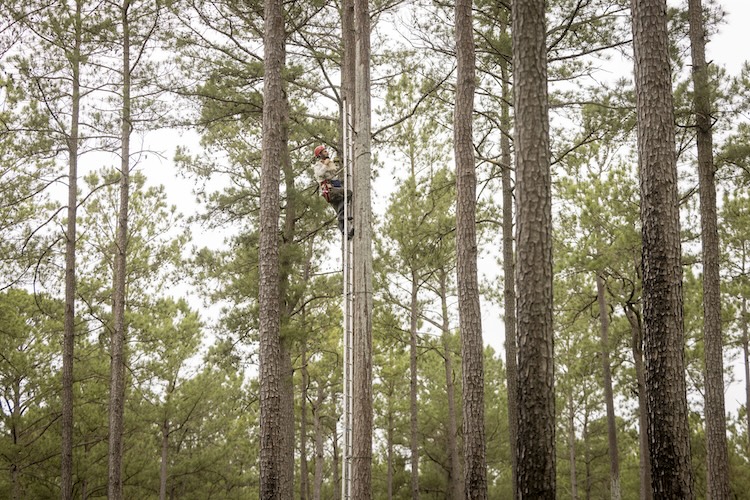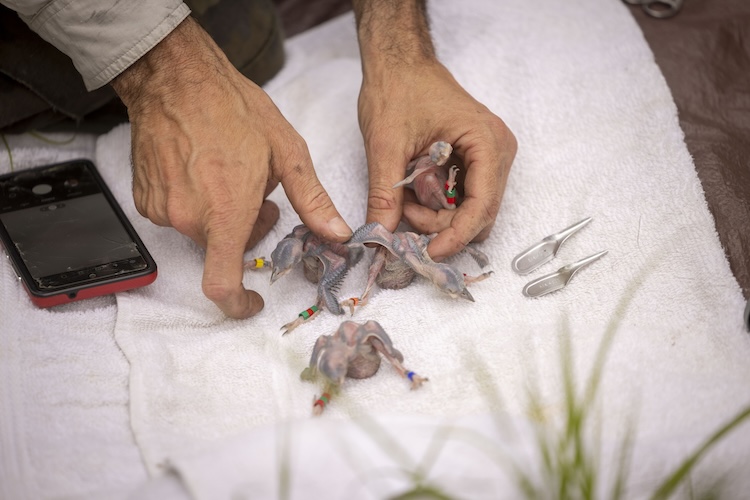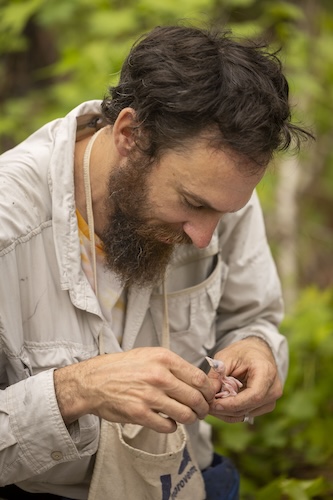Back From the Brink
W&M’s Center for Conservation Biology partners with federal, state and private organizations to save red-cockaded woodpeckers from extinction
July 2, 2025
By
Annie Powell M.A. ’18, Ph.D. ’24
Photography By
Tim Sofranko
Editor’s note: A longer version of this article was featured in the fall 2025 W&M Alumni Magazine.
On a drizzly morning in May, Chance Hines, a research biologist with William & Mary’s Center for Conservation Biology (CCB), climbed 60 feet up a 120-foot-tall loblolly pine tree in search of red-cockaded woodpecker chicks. He found four chicks in a nest cavity in that tree. After removing them one by one, to the dismay of their circling parents, Hines placed them in a sack around his neck and climbed back down.

Chance Hines climbs a loblolly pine tree to find red-cockaded woodpecker chicks.
At 6 days old, the chicks looked like tiny ancient Pteranodons — featherless, with protruding wings, legs and necks. Their eyes, not yet open, could be seen under translucent skin. With time, however, the chicks will develop black and white feathers, with a characteristic red stripe, or “cockade,” along the side of the males’ heads.
Hines’ temporary removal of the blind, helpless chicks from their nest was in the service of a higher purpose — to save the red-cockaded woodpecker from extinction. Such efforts are working: The species, previously listed as “endangered” under the Endangered Species Act of 1973, was downlisted to “threatened” by the U.S. Department of the Interior in October 2024.
“The reclassification is indicative of successful conservation activities,” Hines says.
Those conservation activities include monitoring the red-cockaded woodpecker population and revitalizing the birds’ habitat of old-growth pine forests. That work has emerged largely from a successful partnership between the CCB, which manages the population as part of its mission to restore the at-risk avian species, and a collection of federal, state and private organizations, which manage the habitat. Those organizations include the U.S. Fish & Wildlife Service, the Virginia Department of Wildlife Resources, the Virginia Department of Conservation and Recreation and The Nature Conservancy.

“While the CCB works more directly with the birds, our partners are instrumental in protecting land that is important to red-cockaded woodpeckers and managing that land, primarily through prescribed fire,” says Hines. By thinning out forest growth, prescribed burns help to restore the habitat where the birds thrive. (Read more about William & Mary’s involvement in conducting deliberately planned and carefully supervised fires in our W&M Alumni Magazine feature “Rising from the Ashes.”)
As a native species to Virginia’s pine forests, red-cockaded woodpeckers adapted to the region’s historically frequent lightning fires. They prefer to create nesting cavities in live trees, for example, since dead trees are usually destroyed in fires.
Considered a “keystone species” by the Virginia Department of Wildlife Resources, red-cockaded woodpeckers are an essential part of the Southeast’s pine forest ecosystem. “They are constantly working on creating new cavities and often abandon older cavities after new ones are completed,” Hines says. “These abandoned cavities provide nesting cavities for many other nesting birds as well as reptiles, amphibians and mammals. Because of this, the animal diversity at sites with red-cockaded woodpeckers is really great.”
Much of the danger to these birds stems from habitat loss. Their original habitat spanned from New Jersey south to Florida and west to Texas. But decades of logging practices and unmanaged landscapes reduced the birds’ numbers significantly: By 2002, only two breeding groups were left in Virginia, according to The Nature Conservancy.

Collaboration between university, federal, state and private organizations has saved the species. Thanks to the CCB’s monitoring of the population and its partners’ revitalization of the landscape, the number of red-cockaded woodpeckers in Virginia has increased to well over 100.
Such success does not mean that conservation efforts on behalf of the species will stop, however. “The downlisting from endangered to threatened will mean that there will be more flexibility for managers or industries that interact with the species. But in the absence of naturally occurring widespread fires throughout the landscape, the red-cockaded woodpecker habitat will still require management to sustain the existing population,” Hines says.
Red-cockaded woodpeckers know something about collaboration themselves: Unlike most woodpeckers, they work in family units to build cavities for their nests and raise their young.
“They live in cooperative groups,” Hines says. “These groups include a breeding pair and up to several helpers that assist with raising the young. This means we can’t assume the first two birds we see are the parents.”
Before Hines returned the collection of chicks to their nest 60 feet above the forest floor, he and Bobby Clontz ’89, statewide fire manager and long leaf pine specialist at The Nature Conservancy, had work to do.
As Hines removed the chicks from the sack, he and Clontz weighed them (about 2 ounces each), estimated their age (about 6 days old) and recorded the measurements. Then, for each chick, Hines secured three colored bands around one leg and a single colored band and a single metal band around the other leg, which will serve as identification tools for researchers as the chicks advance to adulthood. The metal band even includes a unique ID number issued by the federal government.
The four chicks that Hines banded in May will face numerous challenges as they grow up — finding food, sheltering from weather and predators and attracting a mate. But, although they don’t know it, the chicks have teams of people on their side, working hard to ensure their successful addition to a thriving red-cockaded woodpecker population in Virginia.